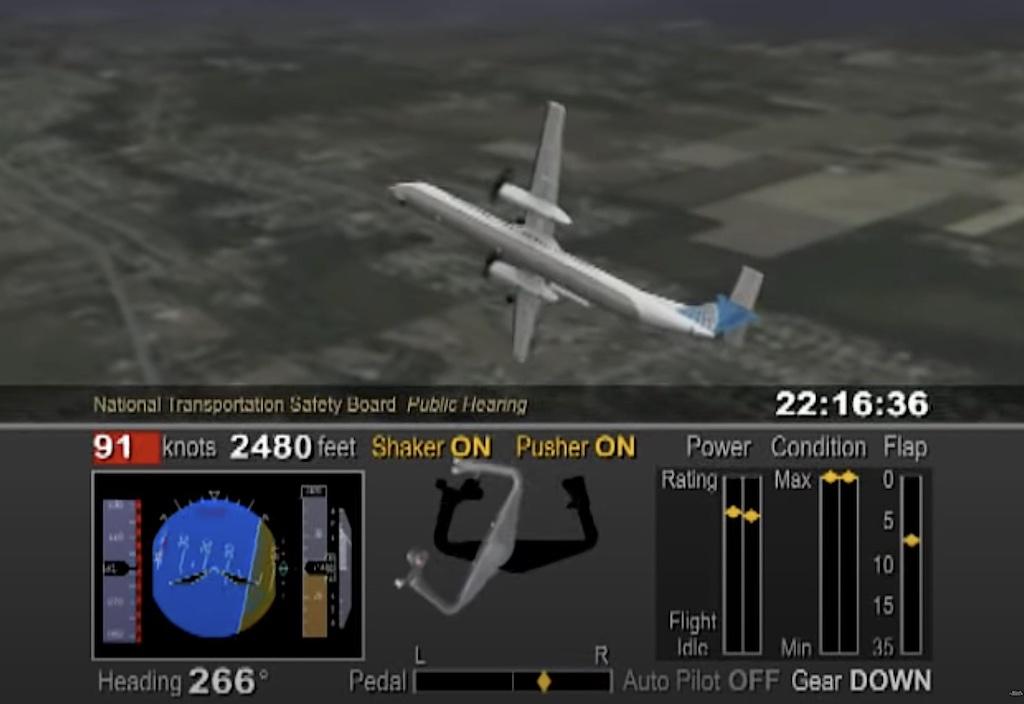
Flight animation of Colgan Air Flight 3407, which crashed in Buffalo on Feb. 12, 2009.
When we simulate flight in training devices, differences between the simulator and real flight are inevitable. While we complain about these differences when we’re flying “the box,” we also learn to discount the imperfections of the simulator to practice the skills that are important to us. Sometimes, however, we begin to accept ideas that are wrong.
For many years, we airline pilots flew a “stall series” in simulators that couldn’t replicate the actions of a real stall. As a substitute for a real stall recovery, we did “approaches to stall,” which could be done with the limited technology of the simulators we had. To demonstrate proficient handling of the simulated airplane, we were required to show we could recover from a stall warning without losing altitude. Recoveries required adding power and deftly handling pitch and trim.
The old stall series became so predictable, airline pilots could all do them with aplomb. I never thought anyone believed for a minute that this was the way to recover from a real stall. Most of us had been trained in military airplanes and had done aerobatics and recovered from many stalls and spins before we began flying the bigger airplanes. We knew how to recover from stalls and we accepted the limitations of the simulator.
A shocking accident made me realize that I had underestimated the effect of repetitive, misleading “negative” training. An Airborne Express DC-8-63 stalled during a functional check flight (FCF) and crashed into mountainous terrain near Narrows, Virginia, in December 1996, killing the six people on board. In command was a pilot who had a background similar to mine. We both flew C-141s in the Air Force and Boeing 727s for Braniff. His daughter went to the same preschool as mine. I was sure he understood proper stall recovery procedures.
Unfortunately, a senior manager at the company insisted that their DC-8s be recovered from stalls using power rather than pitch. The company’s old level B simulator allowed this misconception to be furthered in training. When the flight crew intentionally stalled the airplane as part of the FCF profile, both pilots left the nose high while the engines compressor-stalled and the airplane descended out of control. My old colleague succumbed to pressure from a manager and false training.
More air carriers experienced stall-caused accidents. From 1996 to 2008 four large jet transports and 16 turboprops had stall-induced accidents in the U.S.
The old FAA-approved “approach to stall” simulator training continued at airlines until it led to a crisis in 2009. Colgan Air Flight 3407 crashed in Buffalo in February that year as the captain repeatedly did the wrong thing. Instead of lowering the nose and reducing angle of attack, he pulled back. Doing so was consistent with the “maintain level flight” goal he had been taught. He lacked the background in real stalls and spins that we used to take for granted with airline pilots.
After that accident, the NTSB issued recommendations to change airline simulator stall training. Safety Recommendation A-10-24 called for improved simulator fidelity and A-10-22 for training that incorporated fully developed, unexpected stalls involving autopilot disengagement. The FAA responded with Advisory Circular 120-109 in 2012 and rule changes to training in 2013. Part 121.423 now governs airline training for stalls and other “extended envelope” maneuvers.
The question is, now that more than a decade has passed since the recommendations were written, did they work? I think the answer is unequivocally “yes” for Part 121 operators.
In 2012 and 2013, before the FAA’s new training was introduced, there were two incidents in which regional airline pilots failed to recognize the stall and pulled back on the controls. Both eventually recovered. In 2014, the crew of a regional jet experienced an icing-related stall in the flare. With those caveats, no airline pilot has had an accident because he mismanaged a stall since 2009.
For the other segments of aviation, the record is mixed. Safety Recommendation A-10-22 called for Part 135, Part 91K and Part 142 training centers to make the same changes as airlines. When the NTSB closed out the recommendation in 2021, the board relented on this. The FAA said that upset recovery did not appear to be a factor in Part 135 accidents, and the guidance in AC 120-109A (Change 1) was adequate for non-airline training.
A look at the 17 Part 135 stall-caused accidents since 2010 confirms the FAA’s argument. The accidents involved such issues as icing, gusty winds, terrain avoidance, excess weight and aft CG, unfeathered props and a too steep climb. Most of these pilots probably didn’t train in simulators and never experienced the kind of negative training that would result in pulling against the stall.
No 91K operator has experienced a stall accident in the last 13 years. The same cannot be said for general aviation as a whole. Despite the fact that all pilots learn how to recover from stalls in their initial training, there have been 1,025 stall/spin accidents in general aviation operations since 2010. It would be good to know what sorts of negative training, if any, might be affecting GA stall training.
FAA AC 120-111 (Change 1) says: “Negative training means training which unintentionally introduces incorrect information or invalid concepts, which could actually decrease rather than increase aviation safety.” During all those years when we were doing the old stall series, few of us realized how it could eventually cause an accident. We didn’t know about negative training.

Comments
Aircraft are ultimately governed by the the laws of physics and aerodynamics, not some foolish notion based on a fundamentally flawed idea. The sad thing is that many other instructors of that era must have just done what they were told. People died as a result.